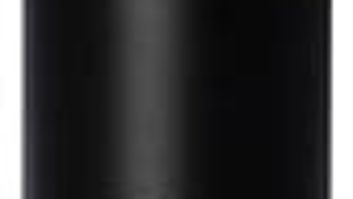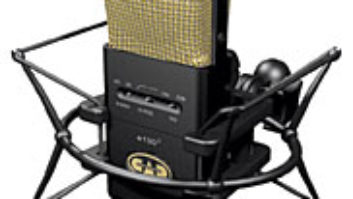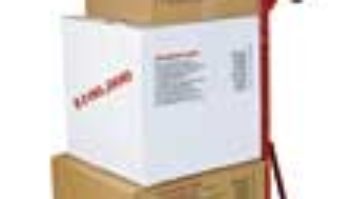When Soundelux Microphone’s co-founder David Bock designed the company’s new E47 tube condenser mic, his goal was to incorporate the “most essential elements” from the out-of-production Neumann U47 tube mic, while keeping a reasonable retail price. At under $4,000, the Soundelux E47 offers U47 fans an emulation of the vintage mic at a significant cost savings.
MIRROR IMAGE
The E47 looks almost exactly like a U47, right down to the distinctive dome-topped head grille. The two mics share the same overall dimensions — 2.5 inches in diameter and 8.95 inches in length — but the E47 sports a smaller-diameter connector at its base. The only other difference in appearance is that the E47 has diamond-shaped, head-grille mesh patterns, as opposed to the U47’s square patterns. The E47 weighs 1 pound, 6.8 ounces; roughly the same amount as the U47.
The E47 offers two different modes of operation: single- and dual-capsule. The E47 ships from the factory set to single-capsule/fixed-cardioid mode, which is how I used the mic for this review. To change the mic’s response to dual-capsule mode, which offers continuously variable polar patterns, you must remove the head-grille assembly (containing the capsule) and aluminum mic body, and then flip a switch located on a metal plate above the vacuum tube. I wish that this switch was more readily accessible.
INCLUDED ACCESSORIES
The E47 is part of a complete system that lists for $3,950 and comes with a three-year parts-and-labor warranty. The mic ships in a sturdy, foam-lined storage box fashioned from beautifully stained Baltic plywood. The large suspension mount that comes with the mic can swivel through 180° of rotation along its vertical axis. Unfortunately, the suspension mount that I received for review required me to apply a significant amount of torque to the swivel lock to keep the mic from sagging out of position.
The E47 connects to its proprietary power supply using a supplied cable that’s roughly 20 feet long and fitted on each end with a 6-pin Tuchel connector; the power supply also features a male XLR connector (for audio output to a mic preamp), power switch, power status LED, IEC receptacle for the detachable AC cord and a continuously variable polar-pattern control knob. This control knob is active only when the E47 is switched to dual-capsule variable-pattern mode. When active, it can smoothly adjust the mic’s polar pattern from omni through cardioid to bi-directional mode in a continuous sweep.
The overall diameter of the E47’s diaphragm is 1.34 inches if you include its mounting ring, or 1 inch if you don’t. The membrane’s thickness is 6 microns. The E47 uses a single JAN submini tube in place of the VF14 used in the original U47. (The VF14 was later replaced with a Nuvistor 13CW4 when the former went out of production.) The JAN submini has the same input impedance as a VF14 but a little less input capacitance, resulting in a 1dB bump in the E47’s response around 10 kHz, compared to the original U47’s response. The JAN submini is internally mounted on springs, padded with silicon foam and heat sunk for long life.
The E47 possesses an input sensitivity of 16.5 mV/PA, ±1 dB, which translates to a considerably hotter output than a U47 produces. Self-noise is rated at 15 dB, A-weighted. The frequency response is stated to be 15 to 18k Hz, ±2 dB. The mic can withstand 134dB SPL for 0.5% THD, a respectable spec for a vintage-style mic.
HEAD TO HEAD WITH A U47
My first test with the E47 was an A/B comparison with a Neumann U47 tube mic (provided by Village Studio Rentals in North Hollywood) on male lead vocals. The vocals were first recorded at six inches from both mics and at a 24-bit depth to Digital Performer using a Millennia HV-3 mic preamp and a Apogee Rosetta A/D converter. Keeping in mind that every U47 sounds at least a little different due to variances in aging factors, the E47 produced less upper-bass content and more extended and slightly brighter highs than the U47 in this application. The U47’s top end sounded a little softer than the E47’s, but the Soundelux mic’s high-frequency response was nevertheless understated in true vintage-mic fashion.
The E47 and U47 sounded even more alike when I recorded the singer positioned within two inches from the mics. Although the E47 still sounded a bit more present than the U47, it offered more upper-bass proximity effect than the U47. Overall, the timbral differences between the two mics were quite subtle.
MAKING TRACKS
The E47 adds fullness to whatever source you feed it, while de-emphasizing sibilance. This is not the best mic to record a wooly sounding vocalist. On both male and female singers, the E47 lent a warm, full vintage sound with a soft top end.
The E47 didn’t sound open enough on acoustic guitar for my tastes. In this application, the low mids were too full and the high end was not extended enough to bring out the “twing” of flat-picked strings. Instead, the high end sounded blunt and “hard.”
Next up was the hard rockin’ Southern California band The Golddiggers, with superb session musician Steven Tate on drums. I placed the E47 just inside the hole in the kick drum’s front head and routed the mic’s output through my HV-3 and Universal Audio LA-2A. This combination imparted a really beautiful top-end snap, but the upper bass and low mids sounded too full and blurry for what I shoot for in a modern rock sound. From what I heard, however, I think the E47 would probably work well recording kick drum on a traditional jazz session.
Finally, the gothic punk band Cutthroat came in to track basics for their upcoming album on Resistance Records. On this session, the E47 sounded great placed as a room mic on trap drums. Patched through an Empirical Labs Distressor, the E47 added wonderful weight and thickness to the overall drum sound. And, placed with care, the balance between cymbals and traps was perfect.
CONCLUSIONS
I found the E47 worked best recording male and female vocals when a vintage sound is desired or as a room mic on drums. The timbral differences between vocals recorded with an E47 and U47 are quite subtle; so much so, in fact, that I can comfortably recommend the E47 as a cost-saving substitute for the U47. (A vintage U47 will typically set you back anywhere from $5,500 to $8,500, if you can find one in good enough condition to justify the purchase.) After applying a little EQ to vocal tracks (which most engineers do when mixing pop music), you’d be hard-pressed to tell that an E47 was used instead of a U47.
In fact, I actually prefer the sound (and higher output) of the E47 to that of the U47. The E47 lends a bit more clarity, focus and detail as compared to the U47. True, you don’t get the U47’s pedigree for your money, but you do get a new, quality-built mic that’s guaranteed to operate for years without problems. Factor in the E47’s lower price, and you’ve got a good deal!
Distributed by Transamerica Audio Group, 4760 West Dewey Dr., Suite 129, Las Vegas, NV 89118; 702/365-5155; fax 702/365-5145; www.transaudiogroup.com.
Mix contributing editor Michael Cooper owns Michael Cooper Recording in beautiful Sisters, Ore.



